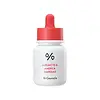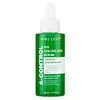What's inside
What's inside
 Key Ingredients
Key Ingredients

 Benefits
Benefits

 Concerns
Concerns

 Ingredients Side-by-side
Ingredients Side-by-side

Water
Skin ConditioningAzelaic Acid
BufferingPropylene Glycol
HumectantSodium Hydroxide
BufferingPentylene Glycol
Skin ConditioningHydroxyethylcellulose
Emulsion StabilisingPanthenol
Skin ConditioningChondrus Crispus Extract
Skin ConditioningChlorella Vulgaris Extract
Skin ConditioningGlucose
HumectantSaccharum Officinarum Extract
MoisturisingGlycerin
Humectant1,2-Hexanediol
Skin ConditioningButylene Glycol
HumectantFructooligosaccharides
HumectantFructose
HumectantEthylhexylglycerin
Skin ConditioningDextrin
AbsorbentTheobroma Cacao Extract
Skin ConditioningMadecassoside
AntioxidantTocopherol
AntioxidantArginine
MaskingWater, Azelaic Acid, Propylene Glycol, Sodium Hydroxide, Pentylene Glycol, Hydroxyethylcellulose, Panthenol, Chondrus Crispus Extract, Chlorella Vulgaris Extract, Glucose, Saccharum Officinarum Extract, Glycerin, 1,2-Hexanediol, Butylene Glycol, Fructooligosaccharides, Fructose, Ethylhexylglycerin, Dextrin, Theobroma Cacao Extract, Madecassoside, Tocopherol, Arginine
Water
Skin ConditioningAzelaic Acid 10%
BufferingGlycereth-26
HumectantGlycerin
HumectantDipropylene Glycol
HumectantNiacinamide 2%
SmoothingButylene Glycol
Humectant1,2-Hexanediol
Skin ConditioningPanthenol 1%
Skin ConditioningCentella Asiatica Leaf Extract
Skin ConditioningCentella Asiatica Extract
CleansingCentella Asiatica Root Extract
Skin ConditioningLactic Acid
BufferingPropanediol
SolventPolyglyceryl-10 Laurate
Skin ConditioningCellulose Gum
Emulsion StabilisingSodium Polyacrylate
AbsorbentDisodium EDTA
Snail Secretion Filtrate 0.98%
Skin ConditioningDecyl Glucoside
CleansingSalix Alba Bark Extract
AstringentCladosiphon Okamuranus Extract
Skin ConditioningCamellia Sinensis Leaf Extract
AntimicrobialAsiatic Acid
Skin ConditioningAsiaticoside
AntioxidantAcetyl Hexapeptide-8
HumectantMadecassic Acid
Skin ConditioningMadecassoside
AntioxidantCoffea Arabica Seed Extract
MaskingCitrus Aurantium Bergamia Leaf Extract
AstringentPinus Densiflora Leaf Extract
AntimicrobialWater, Azelaic Acid 10%, Glycereth-26, Glycerin, Dipropylene Glycol, Niacinamide 2%, Butylene Glycol, 1,2-Hexanediol, Panthenol 1%, Centella Asiatica Leaf Extract, Centella Asiatica Extract, Centella Asiatica Root Extract, Lactic Acid, Propanediol, Polyglyceryl-10 Laurate, Cellulose Gum, Sodium Polyacrylate, Disodium EDTA, Snail Secretion Filtrate 0.98%, Decyl Glucoside, Salix Alba Bark Extract, Cladosiphon Okamuranus Extract, Camellia Sinensis Leaf Extract, Asiatic Acid, Asiaticoside, Acetyl Hexapeptide-8, Madecassic Acid, Madecassoside, Coffea Arabica Seed Extract, Citrus Aurantium Bergamia Leaf Extract, Pinus Densiflora Leaf Extract
 Reviews
Reviews

Ingredients Explained
These ingredients are found in both products.
Ingredients higher up in an ingredient list are typically present in a larger amount.
1,2-Hexanediol is a synthetic liquid and another multi-functional powerhouse.
It is a:
- Humectant, drawing moisture into the skin
- Emollient, helping to soften skin
- Solvent, dispersing and stabilizing formulas
- Preservative booster, enhancing the antimicrobial activity of other preservatives
Azelaic acid is a multitasker ingredient that helps treat acne, pigmentation, and irritation. It is a great option for sensitive skin.
What makes azelaic special?
The best thing about azelaic acid is it's gentleness. It's generally well-tolerated and safe to use alongside other actives like niacinamide or salicylic acid.
Unlike AHAs, azelaic acid will not make you photosensitive/sun sensitive.
You can find this ingredient naturally occurring in grains like wheat, rye, and barley. In cosmetics, azelaic acid is typically lab-made, which is more stable and effective.
Learn more about Azelaic AcidButylene Glycol (or BG) is used within cosmetic products for a few different reasons:
Overall, Butylene Glycol is a safe and well-rounded ingredient that works well with other ingredients.
Though this ingredient works well with most skin types, some people with sensitive skin may experience a reaction such as allergic rashes, closed comedones, or itchiness.
Learn more about Butylene GlycolGlycerin is already naturally found in your skin. It helps moisturize and protect your skin.
A study from 2016 found glycerin to be more effective as a humectant than AHAs and hyaluronic acid.
As a humectant, it helps the skin stay hydrated by pulling moisture to your skin. The low molecular weight of glycerin allows it to pull moisture into the deeper layers of your skin.
Hydrated skin improves your skin barrier; Your skin barrier helps protect against irritants and bacteria.
Glycerin has also been found to have antimicrobial and antiviral properties. Due to these properties, glycerin is often used in wound and burn treatments.
In cosmetics, glycerin is usually derived from plants such as soybean or palm. However, it can also be sourced from animals, such as tallow or animal fat.
This ingredient is organic, colorless, odorless, and non-toxic.
Glycerin is the name for this ingredient in American English. British English uses Glycerol/Glycerine.
Learn more about GlycerinMadecassoside comes from the super popular skin-soothing ingredient, Centella asiatica. It is one of four active compounds found in the extract of Centella Asiatica.
Madecassoside has antioxidant, anti-inflammatory, and hydrating properties. It contains fatty acids, amino acids, beta-carotene, and phytochemicals.
One study found using Madecassoside with ascorbic acid helped reduce the signs of aging and improved skin hydration.
Learn more about MadecassosidePanthenol is a common ingredient that helps hydrate and soothe the skin. It is found naturally in our skin and hair.
There are two forms of panthenol: D and L.
D-panthenol is also known as dexpanthenol. Most cosmetics use dexpanthenol or a mixture of D and L-panthenol.
Panthenol is famous due to its ability to go deeper into the skin's layers. Using this ingredient has numerous pros (and no cons):
Like hyaluronic acid, panthenol is a humectant. Humectants are able to bind and hold large amounts of water to keep skin hydrated.
This ingredient works well for wound healing. It works by increasing tissue in the wound and helps close open wounds.
Once oxidized, panthenol converts to pantothenic acid. Panthothenic acid is found in all living cells.
This ingredient is also referred to as pro-vitamin B5.
Learn more about PanthenolWater. It's the most common cosmetic ingredient of all. You'll usually see it at the top of ingredient lists, meaning that it makes up the largest part of the product.
So why is it so popular? Water most often acts as a solvent - this means that it helps dissolve other ingredients into the formulation.
You'll also recognize water as that liquid we all need to stay alive. If you see this, drink a glass of water. Stay hydrated!
Learn more about Water